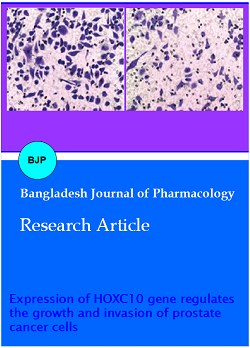Expression of HOXC10 gene regulates the growth and invasion of prostate cancer cells
DOI:
https://doi.org/10.3329/bjp.v16i1.50244Keywords:
HOXC10 gene, Prostate cancer cellAbstract
The present study was undertaken to decipher the role of HOXC10 gene in regulating the growth and metastasis of prostate cancer. The results revealed significant (p<0.05) up-regulation of HOXC10 gene in human prostate cancer tissues and cell lines. The silencing of HOXC10 transcript level significantly (p<0.05) inhibited the growth and colony formation of DU145 and 22Rv1 prostate cancer cells. The DAPI staining revealed that inhibition of DU145 and 22Rv1 prostate cancer cell viability was due to the induction of apoptosis. The transwell assay showed that HOXC10 significantly (p<0.05) inhibits the invasion of prostate cancer cells. The Western blotting revealed that HOXC10 gene exerts its effects via modulation of Ras/Raf/MEK/ERK signaling cascade. Collectively, the results point towards the therapeutic potential of HOXC10 in the treatment of prostate cancer.
Downloads
162
151

Downloads
Published
How to Cite
Issue
Section
License
Authors who publish with this journal agree to the following terms:
- Authors retain copyright and grant the journal right of first publication with the work simultaneously licensed under a Creative Commons Attribution License that allows others to share the work with an acknowledgement of the work's authorship and initial publication in this journal.
- Authors are able to enter into separate, additional contractual arrangements for the non-exclusive distribution of the journal's published version of the work (e.g., post it to an institutional repository or publish it in a book), with an acknowledgement of its initial publication in this journal.
- Authors are permitted and encouraged to post their work online (e.g., in institutional repositories or on their website) prior to and during the submission process, as it can lead to productive exchanges, as well as earlier and greater citation of published work (See The Effect of Open Access).
